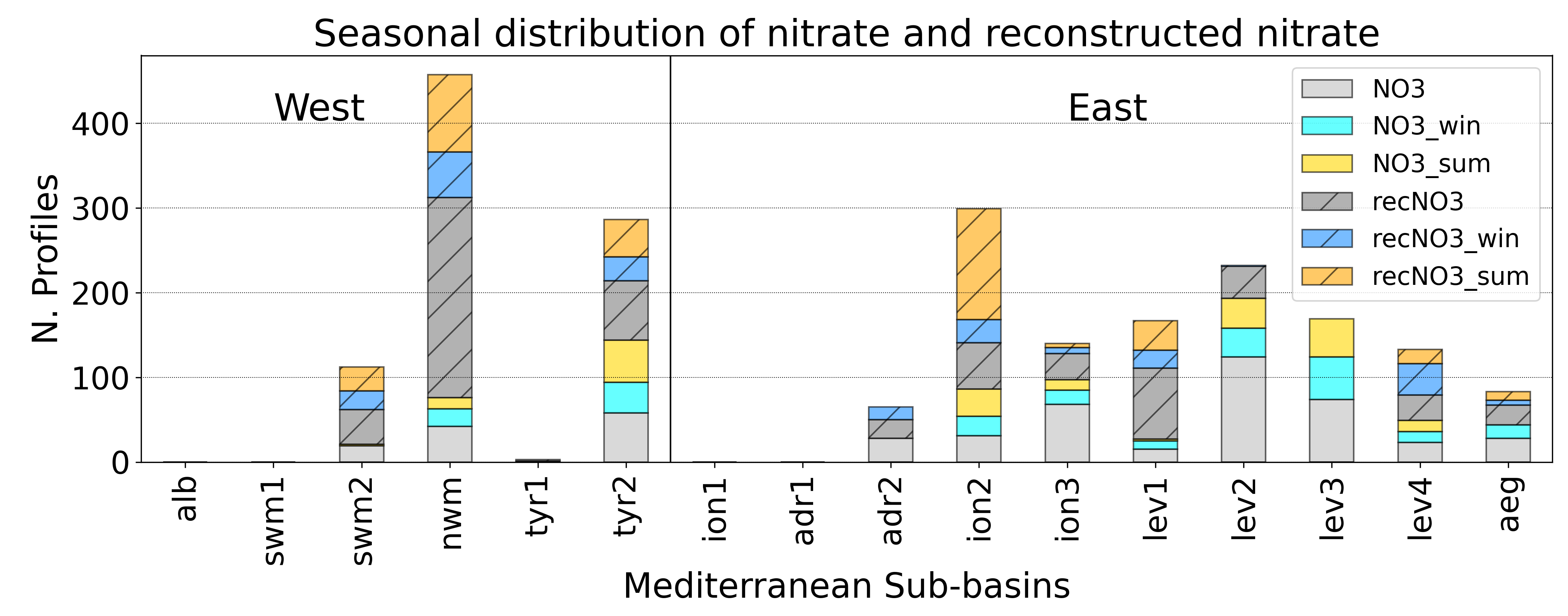Performing Observing System Experiments (OSE) that combine Neural Networks and Data Assimilation to enhance the impact of Argo floats in the Copernicus Mediterranean biogeochemical model (MedBFM)
Ocean Sciences, Modeling
Research area
Biogeochemical-Argo (BGC-Argo) floats provide key insights into vertical biogeochemical dynamics but are limited by data sparsity (data availability is reduced in the last years).
This project aims to investigate the ability of the Copernicus Mediterranean biogeochemical model (MedBFM) to reproduce key BGC features of the Mediterranean Sea by integrating Neural Networks (NN) and Data Assimilation (DA).
BGC-Argo float profiles are assimilated alongside NN-reconstructed BGC profiles.
The impact of these new DA setups is assessed through Observing System Experiments (OSE), demonstrating improved skill metrics, reduced model biases, and enhanced representation of key processes such as nitracline dynamics, primary production, and oxygen vertical distribution.
Project goals
Key challenges include updating the DA scheme to integrate Neural Network (NN)-reconstructed profiles and assessing the associated uncertainties.
The research will:
- Upgrade the DA scheme to incorporate new NN-derived BGC profiles (e.g. chlorophyll)
- Analyze DA uncertainties related to NN-reconstructed profiles, ensuring their reliability in operational forecasts.
- Evaluate the spatial impact of different DA setups, quantifying improvements in model performance.
- Assess the benefits of assimilating NN-reconstructed data, testing its effectiveness in reducing biases and improving biogeochemical dynamics.
- Investigate synergies between different data surches such as satellite, in-situ, and NN-reconstructed observations to maximize their complementary impact on biogeochemical forecasting.
The expected outcome is a DA framework, leading to improved representation of key biogeochemical processes in the Mediterranean Sea and enhanced predictive capabilities within the Copernicus framework.
Computational approach
The project presents significant computational challenges due to the need to build and process large datasets, run high-resolution numerical simulations, and integrate advanced data assimilation (DA) techniques with neural network (NN) reconstructions. Managing large volumes of observation and model outputs from multiple years of simulations requires efficient data handling strategies. The assimilation of BGC-Argo profiles and NN-derived observations generates extensive outputs, demanding resource for the storage.
The high computational cost of running Observing System Experiments (OSEs) with different DA setups adds another complexity. Multi-year simulations at high spatial resolution require substantial computing power, making it essential to leverage high-performance computing (HPC) resources effectively. Efficient parallelization and workflow optimization are crucial to ensure the feasibility of these experiments.
Moreover, the successful integration of NN-reconstructed profiles into the DA system introduces additional technological challenges. First, there is the initial computational effort required to manage and prepare training and test datasets. Second, ensuring compatibility and stability between machine learning outputs and variational assimilation schemes requires careful tuning and validation.
Example of enhanced dataset to assimilate for a 2-year simulation (2018-2019) in the Mediterranean Sea (16 sub-baisn): Seasonal availability of nitrate and reconstructed nitrate profiles. Light gray (autumn and spring), cyan (winter), and yellow (summer) bars represent the availability of in situ nitrate data (used in the DAfl run). Gray (autumn and spring), light blue (winter), and orange (summer) striped bars indicate the availability of reconstructed nitrate data (used in the DAnn run).
Carolina Amadio
Istituto Nazionale di Oceanografia e di Geofisica Sperimentale
Carolina Amadio holds a PhD in biogeochemical oceanography from Ca’ Foscari University of Venice and CMCC, focusing on numerical modeling of benthic-pelagic coupling in coastal areas (Science and Management of Climate Change program). She was a postdoctoral researcher at OGS (Trieste), working on biogeochemical modeling of marine ecosystems, particularly in the Mediterranean Sea, its marginal seas, and coastal areas. Since February 2024, she has held a research position at OGS within the TeRABIT project. Her work focuses on Observing System Experiments (OSE), integrating Neural Networks and Data Assimilation to improve the impact of Argo floats in the Copernicus Mediterranean biogeochemical model (MedBFM). She contributes to European projects such as the Copernicus Marine Program and NECCTON, running multi-year simulations to assess the impact of different model configurations on Mediterranean biogeochemical dynamics.










